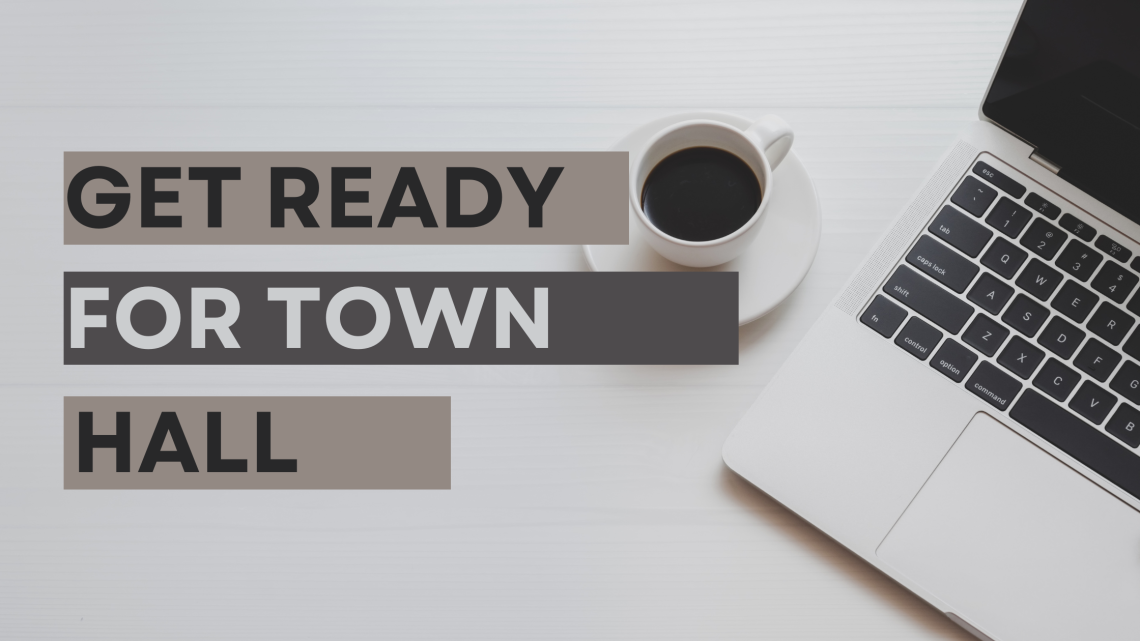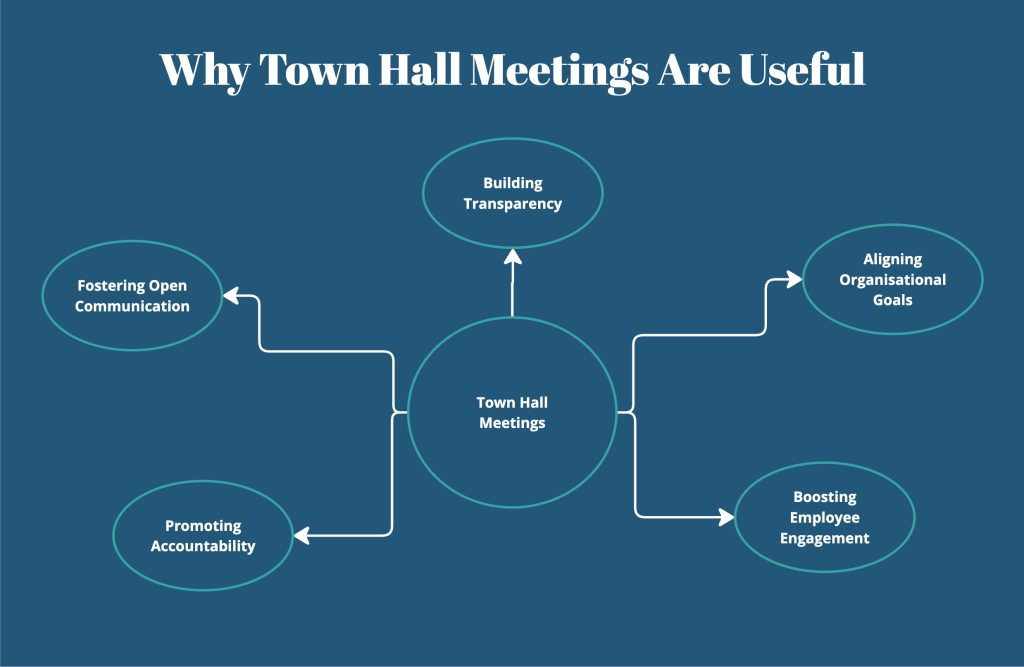
Town Hall Meetings for Companies: What They Are and How to Best Utilise Them
In today’s fast-paced corporate world, effective communication is more important than ever. One of the most impactful ways companies can foster open dialogue and transparency is through town hall meetings. Once a term commonly associated with government assemblies, town hall meetings have found their place in corporate settings, serving as valuable tools for leadership to engage directly with employees.
This article will explore what town hall meetings are, why they are beneficial for companies, and how to best implement them to ensure they serve as a platform for success.
What is a Town Hall Meeting for Companies?
A corporate town hall meeting is a gathering where leadership teams address employees on key issues affecting the company. It often includes updates on business performance, strategic plans, and important announcements. Unlike department-specific meetings, town hall meetings are usually open to all employees, allowing for direct communication between leadership and staff.
Typically, town hall meetings can be held in-person, virtually, or in a hybrid format, making them accessible to companies with a distributed workforce. The format is often interactive, with opportunities for employees to ask questions, provide feedback, or express concerns.
Suggested Format for a Corporate Town Hall Meeting

1. Welcome and Introduction (5-10 minutes)
- Host: CEO, COO or a designated leader
- Content: A brief welcome message from the host, outlining the agenda and purpose of the meeting. Acknowledge the presence of in-person, remote, and hybrid participants.
2. Business Performance Updates (15-20 minutes)
- Presenter: CFO or senior finance leader
- Content: Review of recent financial performance, including key metrics such as revenue, profitability, and growth areas. Share how the company is tracking against its quarterly or annual goals. Include high-level market or industry trends that may impact the business.
3. Strategic Plan Overview (15-20 minutes)
- Presenter: CEO, COO or a CSO (Chief Strategy Officer)
- Content: Discuss the company’s long-term vision, upcoming projects, and strategic initiatives. Include updates on ongoing projects, new product developments, and any changes in business direction.
4. Employee Recognition (10 minutes)
- Presenter: HR leader or manager
- Content: Recognise outstanding employee achievements, highlighting individuals or teams who have made significant contributions. Acknowledge anniversaries, promotions, and other important milestones.
5. Open Q&A Session (20-30 minutes)
- Facilitator: Moderator (usually a senior leader or HR representative)
- Content: Employees have the opportunity to ask questions. The facilitator collects questions beforehand (via email or an anonymous platform) and during the meeting (live Q&A tools or raised hands). Ensure a mix of pre-submitted and live questions are addressed.
6. Feedback and Action Plans (5-10 minutes)
- Presenter: CEO or HR leader
- Content: Summarise key feedback from the Q&A session, outline how leadership plans to address employee concerns, and emphasise the commitment to action. Mention specific follow-up steps and timelines.
7. Closing Remarks (5 minutes)
- Host: CEO, COO or senior leader
- Content: Conclude the meeting by thanking employees for their participation, reiterating key takeaways, and providing any final thoughts. Encourage ongoing communication and remind employees of upcoming meetings or initiatives.
Why Town Hall Meetings are Useful for Companies
Fostering Open Communication
Town hall meetings allow employees to engage directly with leadership, breaking down communication silos. Employees get the chance to ask questions that might not be addressed in regular communications, leading to a deeper understanding of the company’s direction.
For example, at Company X, during a period of restructuring, employees were concerned about job security, but these worries weren’t being addressed in regular communications. To bridge this gap, the company introduced quarterly town hall meetings where the CEO and executive team openly discussed the restructuring process. Employees were encouraged to submit questions anonymously, and one recurring concern about potential layoffs was addressed directly by the CEO, who provided clarity on the future of the workforce. This open dialogue helped alleviate employee anxiety, and ensured a deeper understanding of the company’s direction, showing the value of transparent communication.
Building Transparency
Transparency in a company is crucial for building trust. Through town halls, leadership teams can address concerns, share challenges, and present successes with honesty. This openness helps employees feel included and valued in the overall vision of the company.
For example, at Tech Company X, after missing a major quarterly revenue target, leadership used the next town hall meeting to openly discuss the reasons behind the shortfall. The CEO shared both the external market challenges and internal mistakes that contributed to the issue, while also outlining the steps being taken to recover. By addressing the setback honestly and sharing the recovery plan, employees felt included in the company’s journey, reinforcing trust and showing that the leadership valued transparency, even during tough times.

Aligning Organisational Goals
Town hall meetings provide a platform for aligning everyone on the same page. Leadership can communicate the company’s mission, vision, and objectives, ensuring that all employees understand their role in achieving these goals.
For example, at Company X, after setting ambitious growth targets for the upcoming year, the leadership team used the town hall meeting to clearly communicate the company’s mission and vision for the future. The CEO explained how the new objectives tied into the company’s broader strategic goals and broke them down by department, showing each team how their work contributed to the overall success. By explaining the roadmap and aligning each team’s responsibilities with the company’s vision, employees left the meeting with a clear understanding of their role in helping the organisation achieve its goals, fostering unity and focus across the company.
Boosting Employee Engagement
When employees feel their voice is heard, they are more likely to feel engaged and motivated. Town hall meetings foster a sense of belonging and importance, as employees can see how their contributions fit into the bigger picture.
For example, at Tech Company X, the leadership team introduced a “Spotlight” segment during their quarterly town hall meetings, where employees from different departments could share innovative projects or ideas they were working on. One employee’s suggestion for improving the company’s customer support system was highlighted during a town hall, leading to its eventual implementation. By giving employees a platform to present their ideas and recognising their contributions in front of the entire company, the town hall meetings significantly boosted engagement. Employees felt valued and motivated, seeing how their individual contributions directly impacted the company’s success.
Promoting Accountability
By directly answering employee questions and addressing concerns, leadership is held accountable for their decisions. Employees appreciate the opportunity to hold their leaders accountable, which in turn increases trust and morale.
For example, at Enterprise X, employees raised concerns during a town hall meeting about the delayed rollout of a promised wellness program. The CEO directly addressed the issue, acknowledging that the delay was due to budget reallocations but committed to a specific timeline for its launch. In the following town hall, leadership provided updates on the progress, showing they were following through on their promises. By openly addressing concerns and holding themselves accountable for meeting deadlines, leadership gained employees’ trust and reinforced a culture of responsibility and transparency within the company.

How to Best Utilise Town Hall Meetings
Set Clear Objectives
Before hosting a town hall meeting, it’s important to define the objectives. Are you communicating a change in strategy, celebrating company wins, or gathering feedback? Clear objectives will ensure the meeting stays on track and is productive.
Encourage Participation
Make sure employees are engaged by offering interactive elements such as Q&A sessions, anonymous feedback forms, or live polls. Virtual platforms often allow for real-time participation from employees across different locations.
Effective Communication
Leaders should aim for clear and concise communication. The presentations should be engaging and easily understandable, avoiding corporate jargon that might alienate or confuse employees.
Follow Up on Feedback
One of the most important aspects of town hall meetings is the follow-up. Addressing the concerns raised and showing that leadership has acted on feedback will reinforce trust and ensure employees feel heard.
Use Technology
For global or remote teams, utilizing technology is key. Platforms like Zoom or Microsoft Teams can facilitate virtual town hall meetings, while live polls and Q&A tools keep the meeting interactive.
Create a Safe Space for Open Discussion
It’s essential that employees feel comfortable expressing their concerns or opinions during town hall meetings. Leaders should create an environment that promotes honest dialogue without fear of retribution.
Schedule Regularly
Consistency is key. Holding regular town hall meetings ensures ongoing communication and prevents the build-up of unresolved issues. Whether quarterly or bi-annually, maintaining a schedule helps establish a culture of transparency.
Town hall meetings are invaluable tools for fostering open communication, transparency, and employee engagement. They offer companies the opportunity to align their workforce with strategic goals, boost morale, and maintain accountability at all levels of leadership. By following best practices—setting clear objectives, encouraging participation, and following up on feedback—organizations can make the most of these meetings, creating a more inclusive and productive work environment.




